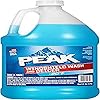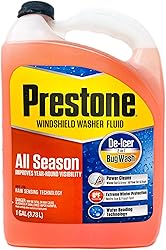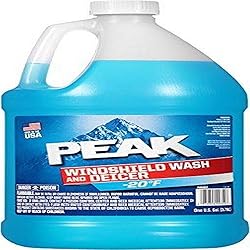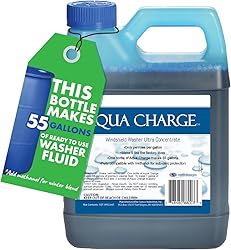Washer fluid isn’t the most exciting thing under your hood — until you’re driving 70 mph and your windshield looks like a bug graveyard. I’ve been there, smearing it all with cheap blue liquid that only makes it worse. So I set out to find the best windshield washer fluid that actually clears the mess without leaving streaks, smears, or regrets.
Winter slush, summer bugs, dusty highways — I put a bunch of popular formulas through all of it. Some held up like champs, others barely beat tap water. Here’s what’s worth pouring into your tank (and what should stay on the shelf).
Best Windshield Washer Fluids of 2025
| Image | Model | Type | |
|---|---|---|---|
 | Best All-Season Windshield Washer Fluid Prestone AS658P All Season 3-in-1Editor's Choice Type: All-Season Check Price | All-Season | Check Price |
 | Rain-X All Season 2-In-1 Windshield Washer Type: All-Season Check Price | All-Season | Check Price |
 | Best Summer Washer Fluid for Bug Season HS 29.606 Bug WashType: Summer Check Price | Summer | Check Price |
 | UltraVision Windshield Washer Fluid Type: Summer Check Price | Summer | Check Price |
 | Best Winter Washer Fluid for Extreme Cold Prestone AS250 De-Icer Windshield Washer FluidType: Winter Check Price | Winter | Check Price |
 | PEAK DE-ICER Windshield Washer Fluid Type: Winter Check Price | Winter | Check Price |
 | Sanco Industries Aqua Charge Concentrated Type: Concentrate Check Price | Concentrate | Check Price |
- Prestone AS658P is the most reliable all-season pick — it handles bugs, frost, and rain without streaking.
- HS Bug Wash stands out in summer — perfect for bug-heavy highways and dusty roads.
- Prestone De-Icer is the clear winner for harsh winter use, with freeze protection down to -27°F.
- Aqua Charge is unbeatable if you want maximum value and don’t mind mixing it yourself.
- Always check the freeze rating — too high, and your washer fluid might turn to slush when you need it most.
1. Prestone AS658P All Season 3-in-1
If you want a washer fluid that just works year-round, Prestone’s 3-in-1 blend is hard to beat. It’s got freeze protection down to 0°F, solid cleaning power in summer, and even rain-beading action. What stood out to me is how well it handles everything from salt spray to bug guts — and without leaving streaks.
It’s also low-VOC, which means it’s a bit easier on the environment (and possibly your garage). The only downside? One gallon doesn’t stretch far, especially if you’re constantly topping off.
Pros:
- Reliable in both winter and summer
- Rain-repelling formula
- Streak-free even on sensitive windshields (yes, even Teslas)
Cons:
- On the pricier side for a single gallon
2. Rain-X All Season 2-In-1 Windshield Washer
Rain-X is a go-to for anyone who’s ever used their water-repellent glass treatment. Here, it’s built right in. This washer fluid handles rain, snow, road film, and grime, all while keeping your windshield clear longer thanks to its beading effect.
It’s a bit more expensive and restricted in some VOC-regulated areas, but performance-wise, it punches well above average.
Pros:
- Great visibility in rain
- Handles bugs, salt, and light frost
- No hazy streaks or glare
Cons:
- Not available in some states due to VOC regulations
3. Prestone AS250 De-Icer Windshield Washer Fluid
When temperatures really drop, you don’t want your washer fluid turning into a windshield ice sculpture. This one goes down to -27°F, and it actually melts frost on contact — no scraping needed.
It’s clean, streak-free, and built to survive deep winter. Not ideal for summer, but it absolutely dominates the freeze.
Pros:
- Works in extreme cold
- Clears frost and light ice fast
- No streaks, even in below-zero temps
Cons:
- Not made for warm-season use
4. PEAK DE-ICER Windshield Washer Fluid
This one’s simple, affordable, and does the job. Rated to -20°F, it keeps your lines from freezing and gets the salt off the glass. It won’t win awards for innovation, but as a no-frills winter fluid, it’s a reliable backup or primary for milder winter zones.
There’s nothing flashy about it, but that’s also kind of the point.
Pros:
- Affordable and reliable
- Methanol-based, works well in cold
- Safe for all vehicles, even EVs
Cons:
- Basic formula with minimal extra features
5. HS 29.606 Bug Wash
This one is purpose-built for summer — bugs, tree sap, road grime. It cuts through all of it with a streak-free finish that’s especially noticeable at night.
It’s not for freezing temps, but if your main issue is bug guts and hot weather driving, this fluid earns its keep.
Pros:
- Great at breaking down bug splatter
- Streak-free, clear finish
- Strong value for frequent use
Cons:
- Not suitable for winter or freezing temps
6. UltraVision All Weather Windshield Washer Fluid
Marketed as all-weather, but this one really lives in summer territory. It does okay with dust, pollen, and daily grime, but doesn’t stand out compared to other summer blends. Also, it’s intensely blue — like, really blue — and that might leave traces on light-colored cars.
A fine pick for basic cleaning, but there are stronger contenders.
Pros:
- Cleans general dirt and bug mess
- Safe for plastic and glass surfaces
Cons:
- Effect is comparable to cheaper brands
- Bright dye may stain surfaces
7. Sanco Industries Aqua Charge Ultra Concentrated
This tiny bottle makes up to 55 gallons of fluid — yes, really. You’ll save money and plastic, and it performs just as well as most premixed options when diluted right.
But it’s messy. No measuring cap, it stains hands and counters, and it needs methanol added for winter use. Still, if you’re a DIY type, it’s a no-brainer.
Pros:
- Huge value per gallon
- Customizable for season
- Performs on par with store-bought blends
Cons:
- Can stain and spill easily
- Needs methanol for cold climates
Buyer’s Guide: How to Pick the Right Windshield Washer Fluid Without Guessing
Cold? Hot? Bug Season? Start with the Basics
Washer fluid isn’t one-size-fits-all — what works in a Texas summer is useless in a Minnesota blizzard. So first things first: figure out the weather you’re up against. Winter blends have antifreeze chemicals (think methanol or glycol) to keep things flowing below freezing. Summer blends? All about cutting through bug guts and pollen. And then there are all-season mixes that try to balance both — though some are better at it than others.
Freeze Point Isn’t Just Marketing
If you’ve ever turned on your washer in January and heard nothing — congrats, you’ve frozen your lines. Always check the freeze protection rating. For cold climates, aim for -20°F or lower. Anything less, and you’re rolling the dice.
Not All Fluids Are Car-Friendly
Some of the cheaper stuff is loaded with ammonia or low-grade solvents that can mess with tinted windows or dry out your wiper blades. It’s not just about cleaning — it’s about keeping your car’s parts from slowly deteriorating every time you wash your windshield.
And yes — some states actually regulate what goes in your washer tank. According to the California Air Resources Board, summer formulas sold statewide must stay under 1% VOCs, while winter blends can go up to 25% — but only in designated “Type A” cold-weather areas. So yeah, read that label before you throw a jug in your trunk during a road trip.
Read the Label Like It’s Fine Print on a Lease
Good fluids list more than just a freezing point. Look for:
- Ammonia-free formula
- Safe for tinted, treated, or plastic windshields
- Clearly labeled freeze protection rating
- Extras like anti-fog, anti-icing, or water-beading features
If it just says “washer fluid” and nothing else — skip it. You’ll regret it the first time it smears bug goo across your entire windshield.
And Don’t Sleep on Concentrates
Yeah, it takes five more seconds to mix. But products like Aqua Charge can save you a ridiculous amount of money if you don’t mind a little DIY. Just remember: if you live where it freezes, you’ll need to add methanol yourself — most concentrates are summer-focused by default.
How to Fill It Right (Because Yep, People Get This Wrong)
Open your hood, find the cap with the windshield/wiper icon, and pour the fluid in — don’t overfill. That’s it. Don’t mix winter and summer blends unless the label says it’s okay. And no, don’t top it off with water — unless you enjoy scrubbing mineral streaks off your windshield.
One Last Tip
If you’re always driving through bug zones or dusty backroads, go through fluid fast. Keep a spare gallon in the trunk. The worst time to run out is during a bug storm at 70 mph.







